
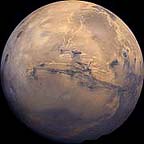 Mars,
"the red planet," derives its name from the Roman god
of war. With a diameter of 6,794 km, it is about half the size
of the earth. Like earth, it contains a thin crust overlain by
a rocky, partially molten mantle. The crustal rocks are composed
of basaltic lavas. Although Mars may have been tectonically active
in its early history, there is no evidence of geologically recent
horizontal motion similar to plate
tectonic motion on earth. Volcanism on Mars may be partly
derived from the melting of hot mantle plumes. The lack of lateral
motion means that these mantle hotspots
would remain fixed relative to the Martian surface. This mechanism
may account for regional uplift and volcanism at several sites
on the Tharsis bulge, the extensive light-colored
region on the west side of the image shown here. The Tharsis bulge
is associated with a number of exceptionally large volcanoes,
which show as dark red spots on the western side of the image.
The enormous Valles Marineris canyon system is visible
in the center of the image, east of the Tharsis bulge. This huge
feature contains numerous canyons, with depths from 2 to 7 km,
exposed over a distance of 4500 km (for a close-up view, double-click
Valles Marineris).
The Marineris canyons were not eroded by running water, but rather
by stretching and cracking of the crust during mantle-plume uplift
of the Tharsis bulge. However, there is clear evidence of ancient
water erosion on Mars, which may date back to nearly 4 billion
years ago.
Mars,
"the red planet," derives its name from the Roman god
of war. With a diameter of 6,794 km, it is about half the size
of the earth. Like earth, it contains a thin crust overlain by
a rocky, partially molten mantle. The crustal rocks are composed
of basaltic lavas. Although Mars may have been tectonically active
in its early history, there is no evidence of geologically recent
horizontal motion similar to plate
tectonic motion on earth. Volcanism on Mars may be partly
derived from the melting of hot mantle plumes. The lack of lateral
motion means that these mantle hotspots
would remain fixed relative to the Martian surface. This mechanism
may account for regional uplift and volcanism at several sites
on the Tharsis bulge, the extensive light-colored
region on the west side of the image shown here. The Tharsis bulge
is associated with a number of exceptionally large volcanoes,
which show as dark red spots on the western side of the image.
The enormous Valles Marineris canyon system is visible
in the center of the image, east of the Tharsis bulge. This huge
feature contains numerous canyons, with depths from 2 to 7 km,
exposed over a distance of 4500 km (for a close-up view, double-click
Valles Marineris).
The Marineris canyons were not eroded by running water, but rather
by stretching and cracking of the crust during mantle-plume uplift
of the Tharsis bulge. However, there is clear evidence of ancient
water erosion on Mars, which may date back to nearly 4 billion
years ago.
There have been 23 scientific missions to Mars, which include Martian flybys, orbiters, and unmanned landings. The first spacecraft to land on Mars was Mariner 4 in 1965, followed by Viking 1 in 1976 and Mars Pathfinder in 1997.
The volcanic features on Mars are very similar in shape, but not in scale, to those found on earth, and they probably formed by similar processes. In contrast to the volcanic features found on the moon, those on Mars were generated on terrains of variable ages. Thus, volcanism has been an important process throughout Martian history. Numerous volcanic landforms can be found in the older cratered highlands and in the younger volcanic plains surrounding them. However, the most impressive volcanic landforms are associated with the extensive, hotspot-related uplifts of Tharsis and Elysium plateaus. The volcanic features described below include the giant central volcanoes, peterae, tholi, and rootless cones.
 The most spectacular volcanic features
on Mars are the isolated, giant basaltic shield
volcanoes called Montes (singular Mons),
Latin for mountain. The largest of these are four giant shield
volcanoes associated with Tharsis uplifted region (for a close-up
view of two of these, double-click Tharsis
Shields). All four dwarf the Mauna
Loa shield volcano, the largest mountain on earth. The
largest of the four is Olympus
Mons, shown in the image here. Olympus Mons is the
largest volcano in the solar system, with a base diameter of ~600
km and 25 km of relief from the summit to the plains surrounding
it abrupt basalt scarp (see image).
The most spectacular volcanic features
on Mars are the isolated, giant basaltic shield
volcanoes called Montes (singular Mons),
Latin for mountain. The largest of these are four giant shield
volcanoes associated with Tharsis uplifted region (for a close-up
view of two of these, double-click Tharsis
Shields). All four dwarf the Mauna
Loa shield volcano, the largest mountain on earth. The
largest of the four is Olympus
Mons, shown in the image here. Olympus Mons is the
largest volcano in the solar system, with a base diameter of ~600
km and 25 km of relief from the summit to the plains surrounding
it abrupt basalt scarp (see image).
These large basaltic shield volcanoes contain large central calderas and gentle slopes that extend outward at angles usually less than five degrees. The volcano flanks have radial surface textures formed from lava channels and long narrow flows.
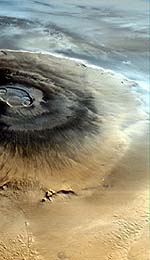
|
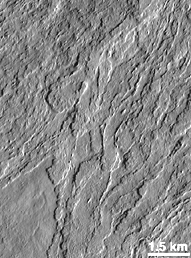
|
|
from its central caldera |
and long, narrow lava flows |
The large scale of the Tharsis shield volcanoes suggests that they formed from massive eruptions of fluid basalt over prolonged periods of time. Similar eruptions on earth are associated with flood basalt provinces and mantle hotspots. However, on earth the source region for hotspot volcanism moves laterally as lithospheric plates travel across the stationary mantle plumes beneath them. Without this mechanism of lateral movement, the Martian surface remains above the plume source so that huge volumes of lava will erupt from a single central vent over many millions of years of activity, thus generating a single shield volcano of enormous volume. With this in mind, it is interesting to note that the volume of Olympus Mons is roughly equivalent to the total volume of basalt in the Hawaiian-Emperor seamount chain.
Compared with the Mons volcanoes, Tholi and Peterae are much smaller volcanic vents. A Tholus volcano is an isolated domal mountain with a central crater, having slopes that are usually steeper than those associated with both Mons and Peterae volcanoes. A Patera volcano is dominated by an irregular or complex caldera with scalloped edges, surrounded by very gentle slopes of usually less than one degree. The lower flanks of both Tholi and Paterae are often buried by more recent volcanic plains. This suggests that some of these volcanoes may be the tops of buried shield volcanoes. Several Tholi and Paterae volcanoes contain sinuous channels carved into their flanks, probably by hot effusive lava flows. Some researchers, however, suggest that the channels were eroded by pyroclastic flows. The scoured flanks of many Tholi and Paterae suggest that they may indeed be associated with a component of pyroclastic activity, in contrast to the massive effusive activity associated with Mons-type eruptions.
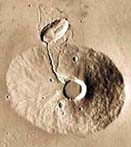
|
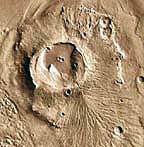
|
|
|
|
High-resolution images from the Mars Global Surveyor have revealed numerous, small cone-shaped structures (< 250 m in diameter) superimposed on the surface of fresh lava flows. However, none of the cones appears to be the source of erupted lava. Similar volcanic features on earth are said to be "rootless," in that they are not positioned above a magma source. Some researchers suggest that these small structures were produced by the interaction of molten lava with a water-rich source. This idea has stimulated a significant amount of interest because, if true, these Martian psuedocraters may mark the locations of shallow water or ice at the time the lava was emplaced.
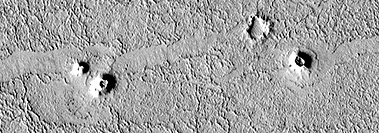
|
| Rootless cones and psuedocraters located on the Amazonis Plains -- This high-resolution image was taken from the Mars Global Surveyor (MGS) Mars Orbiter Camera (MOC). The east-west width of the image is ~6 km. Courtesy of NASA/Malin Space Science Systems/JPL. |